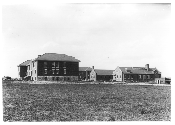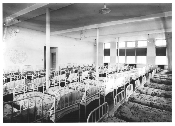The
Langstaff Jail
Farm
 |
| Langstaff Jail
Farm on the northeast corner of today's
Yonge Street and
Highway 7. City of
Toronto Archives |
The corner of
Yonge Street and
Langstaff Road(Highway 7) had not seen
as much action since its heyday as a mid-nineteenth century
toll-gate. But
through the summer of 1913, on land fronting the northeast corner of that old
intersection, the City of Toronto had begun building its celebrated
Industrial Farm
or
Langstaff Jail
Farm.
In today's terminology, it was a minimum security
facility for inebriates, first offenders, and petty criminals, an alternative
to the dreaded Don Jail. But in 1913, and for years afterwards in the memory of
local residents, it was simply
"The Jail
Farm."
 |
| Dormitory room at the
Langstaff Jail
Farm. City of Toronto Archives |
Cottage No. 1, a modest but handsome red brick dormitory,
was the first building completed. Soon it was joined by a kitchen and dining
room complex, barns and silos, more dormitories, implement sheds and farm
out-buildings, a pump house and water tower. The complex stood on some three
square kilometres (about two square miles) of prime agricultural land,
stretching from
Yonge Street east to
Bayview Avenue and
north along Yonge.
Superintendent
Hedley Basher ruled
the
Jail Farm
operation with an iron hand. He had served with the military police during the
First World
War and ran the prison with the same rigid discipline. Neighbours
remember
Basher making his
daily rounds on horseback, "often taking a hedge at full gallop" on his way to
a trouble spot.
Yet there was little need for tight security for
these minor offenders. There were no high fences nor armed guards. "An inmate
could just sneak off and catch the radial car if the fancy took him," recalled
one neighbour. Yet few did, since the penalty for "escaping" was a longer
sentence at a harsher penal institution.
Neighbours soon grew accustomed to seeing groups of
about fifteen inmates, identically dressed in uniforms of faded blue denim
jeans and jackets, "hoeing, weeding, and cultivating crops in small [groups]
all over the property." The farm became largely self-sufficient in providing
food for its residents. Surplus labour was hired out to neighbouring farmers;
wages went directly to the families of these "trusties."
Harry Suter
remembered the
Jail Farm as a
"quiet neighbour" for the 100 or so households who bordered on it during the
1930s.
Young Harry made
the most of this opportunity, running "a black market for all the trusties who
could afford smokes." Commerce was so good that Harry's greatest problem was
"spending all my earnings without my mother finding out."
Harry Suter,"Taking a Look Back at the Old Jail
Farm,"Thornhill Month(May 1987),p. 3
|

